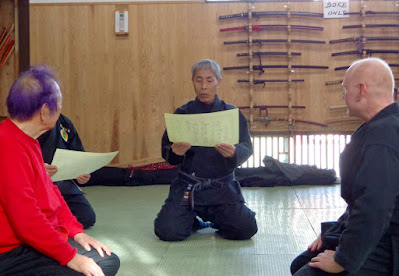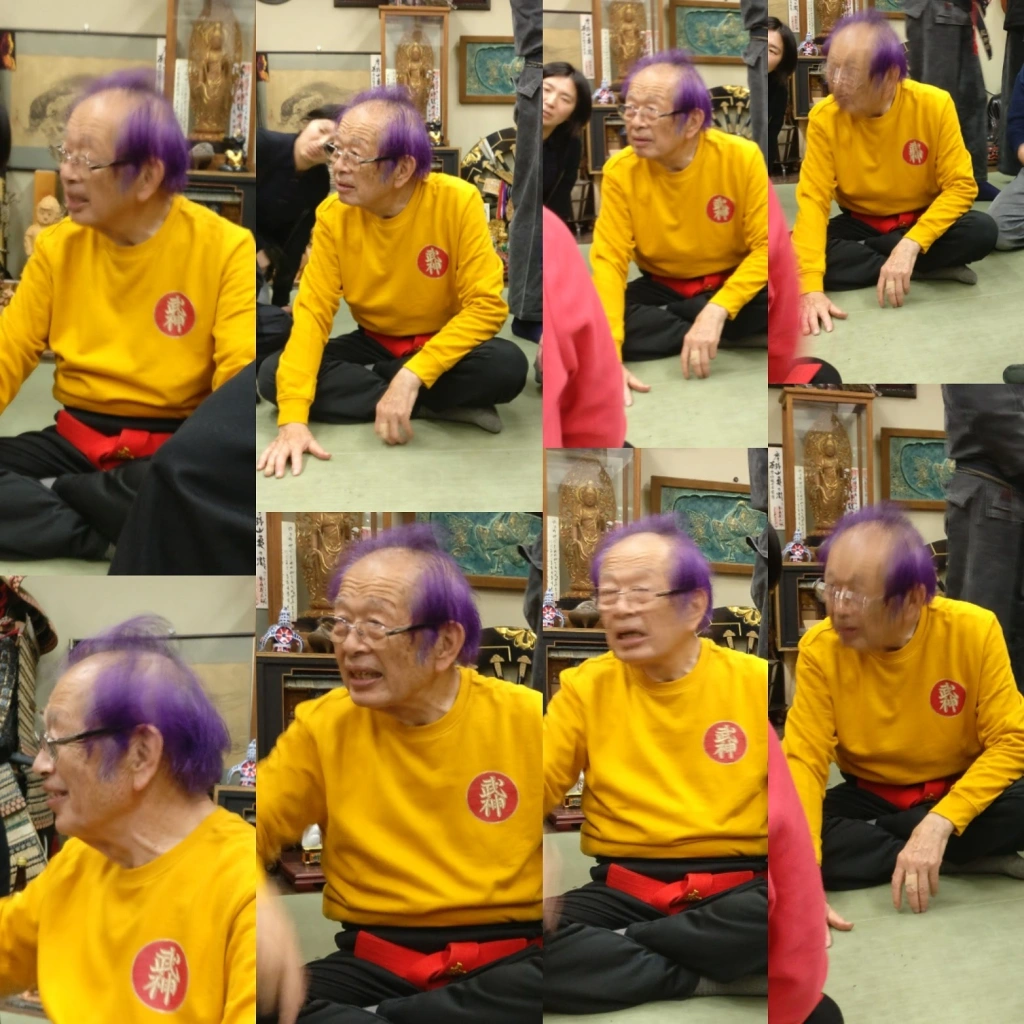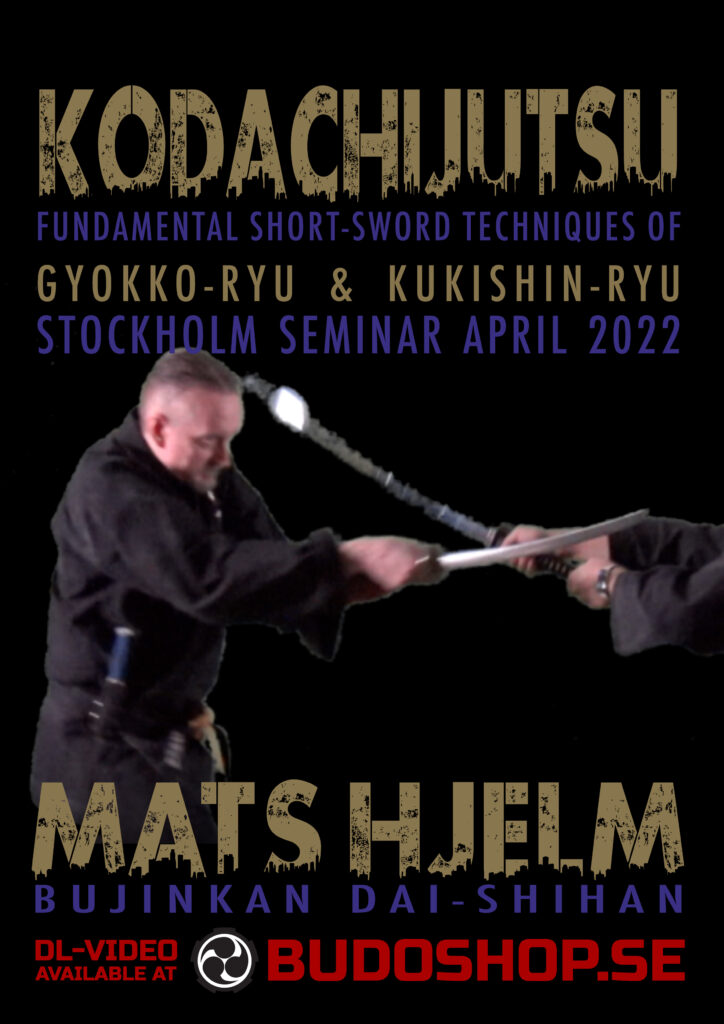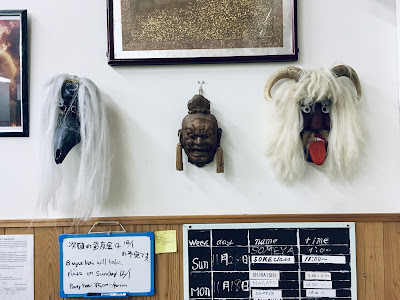Jumonji no Kata
From YŪDANSHA NO AN'NAISHO by YŪDANSHA NO AN'NAISHO
Jumonji no Kata from Kihon Happo…
From YŪDANSHA NO AN'NAISHO by YŪDANSHA NO AN'NAISHO
Jumonji no Kata from Kihon Happo…
From paart budo buki by buki stolar
Hello Budo friends,
for a long time (again) it was not new posts, not that I didn't work, but sens I change my regular job.
There is one weapon (Tsukushi Naginata) about which I think long time and finally it is made first one. As far i know this is first wooden and practice Tsukushi naginata on net and maybe in the world.
From my first steps in Budo world, my thinking was that every decent and serious Dojo should have the possibility to show the student and provide a serious insight into the weapons they teach as well as a deeper insight into the origin and variations of some weapons.
This type of Naginata was created on that trail. There is a small chance that someone could afford an original and real blade, so I tried to incorporate all the essential elements into this weapon so that the practitioner has as faithful a feeling of the weapon as possible.
More about this weapon you could fine on net but I will also will write more about technical aspects and characteristics of this particular weapon.
The Tsukushi Naginata from the picture is made of hornbeam wood from two pieces, similar to the original, the blade is one piece, the handle is another piece, but they are joined with a special joint and glued, with the addition of a special screw so that the weapon be strong when get in contact with opponent's weapon.
For start some pics.
…
From YŪDANSHA NO AN'NAISHO by YŪDANSHA NO AN'NAISHO
Maybe you had problem understanding how I do some of the techniques, well it’s not supposed to be to easy. Anyway we just recorded the second Ura Waza to the Kimon Happo technique Hichō plus a few Henka.
Watch until the end and you will learn how to do Omotegyaku with the ass.
Enjoy!…
From Bujinkan Santa Monica by Michael
 |
| Michael in Leandro Erlich's "The Classroom" at 森美術館, photo Michael Glenn |
I had 5 steps before there were two big changes. Step one was easy for me, but step seven I didn’t even know about until recently. Let’s talk about the easy change first.
As you know, Soke used to set yearly themes for the whole Bujinkan to follow. This made it easy to decide what to study every class. For example, If the theme was Gyokko Ryū, we could study the techniques and strategies from that school.
But one Fall night in 2017 I showed up to the Bujinkan Honbu Dojo in Japan and change was in the air. Hatsumi Sensei’s wife was ill and Soke had made the difficult choice to move her into a care facility. He sat in front of the Kamidana and said a private prayer at his family shrine.
Then he began class talking about change. He told us,
We have lots of Daishihan around the world now. Being able to change is the way of living. Our Tradition continues because it changes. It’s the same feeling as mutōdori. People change as they get older. Now is the time for the Daishihan to take the Bujinkan into the future.
Little did I know I would feel that weight of taking the Bujinkan into the future in less than an hour.
It happened right after the break. Hatsumi Sensei sat on the floor as they cleared away his ink and brushes. Then he looked at some of the Daishihan and said, please nominate anyone you think is worthy to be a Daishihan. Two of them immediately pointed at me.
I was relaxing on the mat behind Soke, so he turned quickly to see who they were pointing at. His face lit up when he saw me and said, “Ok!” I think he noticed my shocked expression because he smiled and quickly called Furuta-San over to talk to me.
 |
| Senou Sensei reads Michael Glenn's Daishihan certificate. photo Peter Crocoll |
In the following class on Sunday Hatsumi Sensei made the formal announcement and presented me with the certificate in front of the whole dojo. I bowed and then Soke said to everyone,
There is a time for these things and when the time is right they should be given.
He continued,
Next year is the start of a new Bujinkan. I started Togakure Ryū with Takamatsu Sensei in Showa 33 (1958). But I hadn’t been training long. But Takamatsu gave it to me to grow into it. Please think about these Daishihan not as coming from me, but from Kamisama. To make a community of great people.
The rest of my trip was filled with thoughts of what did it all mean? One thing it meant when I got back home was that I still had to teach my classes. But Hatsumi Sensei was no longer setting clear themes for us to follow.
I decided it was my responsibility to set themes for my dojo. So far, this has been easy for me. I basically decide what subject I'd like to do a deep dive on and set the theme accordingly. My current theme is Juppō Sesshō and we are using a variety of weapons to explore this.
When preparing to teach a Bujinkan class I must consider what my students need. I anticipate which students will be there that day and what I think will help them the most. Some are beginners, some are advanced and they all need different things from me.
Knowing the theme enables the next step where I review the 伝承 Denshō. I do this to get as close to the original forms and traditions as they were passed down to Hatsumi Sensei. This step is tricky, because translations and copies of the kata are not always accurate.
I use several trusted sources and compare and contrast them to get as close as I can to the “proper” form. I use multiple translations because each one has a different flavor depending on the pedigree of the translator. Then, I even do my own translation to confirm. This takes a long time.
Next, I consult Hatsumi Sensei’s books. In a recent class about the use of jūji sabaki and the jūtte, I have 3 different books with 3 different approaches to the same kata. I compare them with the Denshō to try to get as close as possible to a “kihon” version of the kata.
In each book, the version of the kata that is shown will differ depending on the era the book was written. Or maybe Hatsumi Sensei had a specific focus for that book. I bring that all together with the next step.
After I get the steps down in my class notes, I watch Hatsumi Sensei’s videos. We are lucky that Soke has made a lot of videos. Over the years, I have made notes about where a kata appears in a video so I can fast forward to the exact moment it was shared. Again, the same kata will be presented differently depending on the era and the focus on the day the video was made.
From here, I reflect on my own personal experience and training notes. In normal years, I would make 3 trips to Japan every year. This worked out to about 6 weeks of training with roughly 2-3 classes every day.
This means that there is a good chance I studied any particular kata with Soke or the Japanese Shihan in Japan. I made many detailed notebooks from these studies. Reviewing these notes will trigger a specific memory or insight that will change how I teach the class.
The final step is one that I only recently realized was an essential part of how I prepare for class. This is the idea of 以心伝心 ishin denshin, a direct heart to heart communication between teacher and student. I received this from Hatsumi Sensei.
And I feel like I just woke up to my responsibility as a Daishihan when I discovered this next step.
What is the best way for me to convey Soke’s feeling to my students? This is the final step of my preparation for Bujinkan training. When he awarded me the Daishihan certificate he said,
This year is the 50th anniversary of the creation of the Bujinkan dojo. During this time, there were a lot of people out there who don’t understand what real budo is. And teaching without knowing real budo. Recently, I have been teaching mutōdori and this is 上層部 Jōsō-bu, the highest echelon or essence of budo. Some people understand it and some don’t, but it’s very important.Who can say they understand Hatsumi Sensei's movement? I don't make any claims. But what I can do is try to share the feeling I got from him.
Like the time I tried to grab him and he disappeared. Or the time when he struck me with one finger, moving a bone behind my larynx and I was hoarse for a week. He thought that was quite amusing... Or another time when he threw me on the mats in Ayase and I blacked out. I came to with his face over mine, laughing again.
He gave me a feeling too when he made me a Daishihan. He told us,
It’s important to transmit these things by word of mouth and in person. The Daishihan can teach people how to live around the world. The gokui of mutōdori is really nothingness and very pure. I feel fortunate that I could teach people up to Daishihan level and they can now take over.
This is the future of the Bujinkan right in this room.
I didn't know it that day, but his words still guide me many times a week as I go through these steps to prepare for class. I made a video about all of these steps called Bujinkan Kuden: How I Prepare for Class with the 十手 Jutte if your curiosity drives you to dive deeper.
…
From Bujinkan Santa Monica by Michael
I have been training all of my life. Started in 1985. Around that same time, I also got into film and video production. So when I began teaching Bujinkan and started my own dojo, It seemed like a natural thing to make training videos.
I assumed I would put them out as DVDs. I even made some with chapters, extras (remember those?) and gave them out. But, this was the era of Netflix and streaming video. Many people were abandoning DVDs and VHS was already a dinosaur.
Then my next thought was how can I stream these training videos? I put a few on youtube, a few on amazon, and I quickly realized it was a full time job. Between the teaching of classes, the video production, post production, streaming setup… And the equipment wasn’t free either.
I knew I had a few friends from my mailing list and from social media who might be interested. So I set up the streaming on my new website Rojodojo.com and I began to tell everyone about it:
Here was the #1 post Introducing Rojodojo
I was very nervous about the launch. I am not a natural salesperson. I just love to train, and to share that. But I felt weird charging for it. Even though my students pay me for my classes, and I pay my own teachers for their classes. I was not good about asking for money.
So Rojodojo started out kind of weak. I only got a few signups. Not even enough to cover the web hosting bill.
I even received a bunch of blow back from my current followers. People unsubscribed or unfollowed me. Some even wrote me to complain that who did I think I was to charge for videos?
I decided to focus on the trailblazers who did sign up. Instead of 1,000 true fans, maybe I had 10… But I was so thankful.
I immediately wrote some amateur Japanese calligraphy to mail to them. And then I got to work. Training, writing, and making videos.
Then, every month, more people came on board. And they kept their memberships going month after month. That means if I get 2 people in one month paying $30 each, and 3 people sign up the next month, now I have $150 every month.
It's not a lot, but it arrives every month... like rocket fuel to share and teach everything I have learned about the Bujinkan during my 35+ years of training.
I was surprised at how we grew. New members continued to join even though I am terrible about offering memberships to people. Did I mention I was a bad salesperson?
You can see the growth has been up and down, but steady. I removed the Y-axis numbers because of my tendency towards privacy. That way no one will criticize the amount of support.
A few years into this I wonder why I ever doubted myself. Because a few things became real:
Membership allows me to run experiments and explore. I can focus on very small details like the meaning one of our Kuji, Bujinkan Kuden: 妙剣 Myōken and 突き構え Tsukigamae Which is a fringe topic that only hard-core Bujinkan students would care about.
Or, I can run multi-part series like the 12 episodes of 義鑑流 Gikan-Ryū as taught by Noguchi Sensei. This project was very membership driven. It would never have happened without members supporting it.
Now people from everywhere in the world can study with me. Video classes reach many more students than I ever could in my home dojo. My own students even get recognized whenever they go to Japan or attend seminars (they are the real stars of my videos).
When the pandemic happened and our dojo had to close for a year and a half (California wasn’t playing), I was lucky that my members stayed on. They supported me even when I only made improvised videos and explored odd topics for solo training.
I create for the whole Bujinkan community. My goal for Rojodojo is a continuous and rigorous production of training projects. Because I want to share the martial art I love so much.
Some may not want my approach, or some may be too busy building their own empires to learn from me. But there are many strong students and teachers who have the curiosity and drive to learn.
I will share for them. In every way possible. For the true Ninjas.
If you want in, then join us: Rojodojo Invitation
…
From Bujinkan Santa Monica by Michael
 |
| Real or fake kick? |
How do you trick someone into believing something that isn’t real? You act as if it is real. Or even better, make it real.
This is how I often explain kyojitsu to my students. 虚 kyo means fake, and 実 jitsu means reality. For kyojitsu to work it has to be both real and fake at the same time.
Shihaku has a kick that is kyojitsu. But remember kyojitsu only works if it can be either 虚 kyo or 実 jitsu. Too many people only practice the kyo part of kyojitsu.
Their fake fails because no one would fall for it. So it must be real. Just not necessarily delivered.
This means that if the opponent doesn’t react to your fake, then make it real. And you kick him hard! If he’s not buying what you’re selling, then kick his ass with it.
So when does does the fake become real? Where does that change occur? Hatsumi Sensei demonstrated this on me when he called it 虚実皮膜 kyojitsu himaku.
The way I learned this kick from Hatsumi Sensei was quite interesting. He took it to that in between place of kyojitsu by making the kick 探り saguri geri. Here The kick becomes more of a searching, feeling out, or testing the waters.
But Soke is really probing the opponent’s state of mind. Will he fall for it? Think of a calm mind like the surface of a quiet lake. Then look for the ripples caused by your (fake) kick.
It is like dipping your toe into a pool to see if the water is cold. Is that a kick? The water surface may be broken and disturbed. Our opponent's kamae is also broken and disturbed this way by saguri geri.
I love this in practice because I can often make my opponents fall over without even hitting them. It is because I am striking their mind and spirit. If that fails for some reason, I have the backup of a real kick to the balls and a punch to the gut. I am happy with either outcome!
If you want more of these training tips from me, then please join my newsletter here: Rojodojo
…
From Shiro Kuma by kumablog

Last Friday, we continued the study of the Tenchijin. We trained some basic Gyaku waza movements. After two years of pandemics, our dōjō is still trying to survive. Our training group is so small that it feels like beginning a new dōjō. We might rename the Kuma dōjō the dōjō of the phoenix!
I teach beginners, intermediates, and advanced all at once. Teaching various levels is difficult as each student must learn a form matching their level. If you don’t do that, you lose your high ranks or beginners. Never forget that. In a multilevel class, beginners are also exposed to advanced forms. And they enjoy it.
I recently taught the “step by step” beginners’ form of Musō Dori. Then I moved the level up for the two Jūgodan and the Dai Shihan attending the class that night. After teaching the basic moves, I went up the technical ladder. I offered a more profound vision of Musō Dori to the group. This time I controlled Uke without force. And threw him onto the ground using his body reactions instead of my muscles.
Then I heard “wow, it’s magic!” coming from the beginners’ side of the group.
Disclaimer: This post is about “magic” but there is no magic in Budō. There are only refined basics. Micro-movements are invisible to young practitioners. Locks and throws without grabbing always seem strange or magic to neophytes. This is “Kuki nage”, the Budō concept for “air throw.” (1)
It looks magic to the untrained eyes because the correct ability to see is not developed yet. Practitioners see it, but their interpretations and feelings come in the way. Emotions make them blind to reality. They can’t see the movement. It is invisible from their limited experience. A student of Budō needs years of practice to develop this capacity. Until he gets enough experience, Budō is a “mienai waza”, a technique that you cannot possibly see. (2)
Reality is invisible to young students, who don’t have the level to see what is happening in front of them. That is why they call it “magic!” In fact, you should see a waza as being like an unpolished diamond. The gem’s value resides in the long polishing hours demanded to get the shiny stone. If you find a raw diamond on the ground today, you won’t recognize it, and only a trained geologist would know. Budō is the same.
“Magic” is the name you give to a movement before the long polishing work. When I went to Japan for the first time, each class was a “magical” show to me. Today this “magic” is gone because I learned to do what the Japanese do. It takes time. Magic is Genyō in Japanese. (3)
Genyō is “an enchanting illusion” for beginners. But it is an “original life” (genyo) for the advanced student. (4)(5) Magic (Genyō) changes our perception of life. It turns this “alternative reality” (genyo) (6) into a “dream” (gensō). (7)
Magic doesn’t exist, and we call it “magic” to adjust the perception of reality to our limited understanding.
Stop dreaming and go back to your basics if you want to become a magician one day!
_________________________________
1 見えない技, mienai waza: a technique that cannot be possible seen
2 空気, Kūki: air; atmosphere; mood; situation; someone with no presence; someone who doesn’t stand out at all
3 幻妖, Genyō: magic
4 幻, Gen: phantom; vision; illusion; an apparition; mythical thing; a scarce thing
5 妖, Yō (aya): mysterious; bewitching; alluring; enticing; enchanting
6 原原, Gen+yo: original; primitive; primary; fundamental. Raw + world; society; public; life; lifetime; period; generation; the times
7 幻想, gensō: fantasy; illusion; vision; dream
Check http://www.koimartialart.com the Bujinkan streaming platform
160 Gb of videos covering all waza and weapons of the Bujinkan …
From Budoshop.se by BUDOSHOP.SE
SHORT SWORD FIGHTING techniques with MATS HJELM. During March and April of 2022, we at Kaigozan Dojo studied the “short sword techniques” within our Bujinkan Dojo system transmitted from Masaaki Hatsumi Sōke to Mats Hjelm. 小太刀術 Kodachi-jutsu (Short Sword Techniques). There is three fundamental sword techniques from the Kukishin-ryū, school in the Bujinkan Dojo. Then we also have the Sanshin no Kata from Gyokko-ryu which all the weapons is connected to.The Kodachi has been neglected by most Budō-ka and masters since it was a weapon carried by the higher ranked officials. Masaaki Hatsumi

Mats Hjelm started training in Bujinkan for the first time around 1983. It wasn’t until 1986 when he had the opportunity to start training more seriously under a Shidōshi. He has taught at numerous seminars all around the world, gone to Japan 3-5 times every year. After he started training he never had a training break. He takes his budo training very seriously! If you want to sponsor a seminar or course, please don’t hesitate to contact him. For more information see his web site kesshi.com or come and train with him at Kaigozan Dojo.…
From Budoshop.se by BUDOSHOP.SE
NINJA SWORD FIGHTING techniques with MATS HJELM. During the first two months of 2022, we at Kaigozan Dojo studied the “hidden secret sword techniques” within our Bujinkan Dojo system transmitted from Masaaki Hatsumi Sōke to Mats Hjelm. 秘剣術 Bikenjutsu (Hidden Sword Techniques). There is six fundamental sword techniques from the Togakure-ryū Ninpō-taijutsu school in the Bujinkan Dojo.Happō-biken, eight directional secret sword means: generating an infinite secret sword from the posture of divine mind – divine eyes (心身心眼 SHIN SHIN SHIN GAN). Masaaki Hatsumi

Mats Hjelm started training in Bujinkan for the first time around 1983. It wasn’t until 1986 when he had the opportunity to start training more seriously under a Shidōshi. He has taught at numerous seminars all around the world, gone to Japan 3-5 times every year. After he started training he never had a training break. He takes his budo training very seriously! If you want to sponsor a seminar or course, please don’t hesitate to contact him. For more information see his web site kesshi.com or come and train with him at Kaigozan Dojo.…
From Bujinkan Santa Monica by Michael
 |
| Bujinkan Honbu Masks, photo from same day by Michael Glenn |
Then Soke told us,
空間で嚮導 Kūkan de kyōdō, lead the opponent in the kukan. You must study something beyond waza, beyond technique. Transcend waza. Without avoiding you move like this. Step slowly, then hold it like this. Let’s try that… that will be the end.Now here I am two years later sharing these same tips with my students. I do my best to remember the feeling from Soke that night. I would like to take them in a time machine so we could all eat lunch at the Saizeriya and go to Hatsumi Sensei’s class together. But time travel is only in my head training with my memories.
…